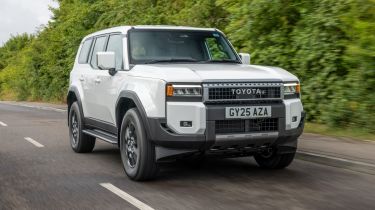Toyota Land Cruiser Commercial van review
Removing the seats to create the Toyota Land Cruiser Commercial produces an interesting alternative to a double-cab pick-up truck
Our opinion on the Toyota Land Cruiser Commercial
While the previous-generation Toyota Land Cruiser Commercial focused on offering a utilitarian 4x4 experience, the latest version is being pitched as a halo model for Toyota’s commercial vehicle line-up. It’s a niche machine, with only limited numbers of commercial 4x4s sold each year, but with a healthy payload, huge towing capacity and plenty of car-like comfort up front, the Land Cruiser Commercial offers a genuine alternative to a double-cab pick-up truck. Off-road ability is excellent, while on the road it’s arguably a better machine than the SUV that it’s based on, with the removal of the back seats reducing weight and allowing the diesel engine to perform more flexibly.
About the Toyota Land Cruiser Commercial
The commercial 4x4 sector is a bit of a niche market in the UK, but it’s still surprisingly busy. Until recently, the Suzuki Jimny Commercial was the entry point to the sector, while cars such as the Land Rover Defender Hard Top and Discovery Commercial, plus the Ineos Grenadier Commercial offer a bit more versatility. Now there’s another option to choose from in the shape of the Toyota Land Cruiser Commercial. With prices starting from around £50,000 ex.VAT, it’s a close match for its Land Rover and Ineos rivals.
Toyota is marketing the Land Cruiser Commercial as a halo model for its Toyota Professional line-up of commercial vehicles. The previous generation was a popular machine that had strong residual values due to its limited supply and high demand, while updates during its life saw it go from a basic machine to one that was relatively well equipped. This time around, Toyota has gone in at the higher-grade end of the market from launch, with the Land Cruiser Commercial featuring kit that comes close to matching the SUV version’s.
Used - available now

2023 Ford
Kuga
26,241 milesAutomaticPetrol2.5L
Cash £21,199
2023 Ford
Kuga
21,283 milesAutomaticPetrol2.5L
Cash £19,949
2019 Ford
Kuga
12,390 milesAutomaticPetrol1.5L
Cash £17,499
2023 Vauxhall
Corsa
17,594 milesAutomaticPetrol1.2L
Cash £13,699The Commercial model is built in Japan on the same production line as the SUV, but as with the Toyota Corolla Commercial that’s made in the UK, Land Cruisers that are destined to be converted are assembled without rear seats, belts or anchor points so that they meet UK commercial vehicle legislation. They are then shipped to Toyota’s manufacturing facility at Burnaston, Derbyshire, specifically the Business Revenue Centre, where they are fitted out with the equipment to turn them into a commercial vehicle, comprising a flat floor section, steel mesh bulkhead and opaque window blanks.
There’s just one version of the Land Cruiser Commercial offered, and it comes in a specification that’s not quite as plush as the Invincible-grade SUV, but is still very well equipped for a commercial vehicle. Uncommon tech includes heated and ventilated electrically adjustable seats trimmed in artificial leather, two-zone climate control, a powered tailgate, front and rear parking sensors and a reversing camera.
Power comes from the same 2.8-litre four-cylinder turbodiesel as in the SUV, a unit which is shared with the Hilux pick-up truck. The Land Cruiser differs from the Hilux in other areas, replacing the leaf spring set-up with a four-link system, and while the pick-up has a six-speed automatic gearbox, the Land Cruiser has an eight-speed auto. The Land Cruiser features permanent four-wheel drive with low-range gears, plus a rear diff lock that allows for 50:50 power distribution front and rear, hill-start assist and a crawl mode for the cruise control.
You can now buy vans with Auto Express! Take a look at our Marketplace for the very best van offers from our massive network of dealers...
MPG and running costs
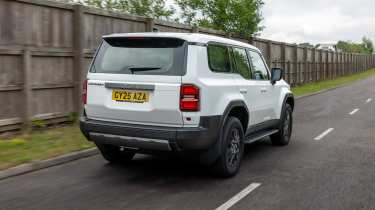
| Pros |
|
| Cons |
|
There’s just one version of the Toyota Land Cruiser Commercial offered, and the only options that will bump up a list price of around £51,000 (ex.VAT) are black metallic paint, illuminated scuff plates or a tow bar.
The Commercial model is a unique trim level that has some of the kit that comes with the Invincible SUV, so it’s generous for a work model. Highlights include 18-inch alloy wheels, LED lights all round, synthetic leather upholstery with heated and ventilated seats, electric adjustment for the driver’s seat, two-zone climate control, front and rear parking sensors and a reversing camera, keyless entry and starting, a nine-inch touchscreen infotainment screen with smartphone connectivity and a full suite of Toyota Safety Sense systems.
Official fuel economy is quoted at 26.6mpg combined, which isn’t very efficient, but then this is a 2.3-tonne 4x4. In comparison, Toyota quotes 26.4mpg combined for the SUV variant. There’s an 80-litre fuel tank on board, so a range of more than 450 miles is possible if you can match the official fuel economy figure.
One area where the Land Cruiser Commercial offers benefits over a double-cab pick-up is taxation. While trucks now pay Benefit-in-Kind rates based on emissions, commercial 4x4s still qualify for the commercial vehicle rate, which is fixed at a far lower percentage. If you can make one of these two-seat models work for your business, then it could be a cost-effective purchase.
Load space and practicality
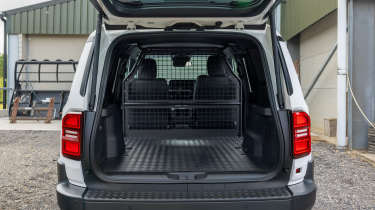
| Pros |
|
| Cons |
|
Commercial 4x4s offer some compromise in terms of cargo carrying, because they balance the need for off-road driving with the amount that they can carry. But given that the Land Cruiser Commercial is based on an already large SUV, it offers a decent capacity.
Measuring nearly five metres long, the Land Cruiser is actually slightly shorter than the Hilux pick-up. At just under two metres wide and 1.925 metres tall, the commercial model is quite imposing, and it means there’s a decent amount of space on board.
To create the cargo area, Land Cruisers are shipped, minus their back seats, from the production line in Japan to Toyota’s UK plant, where they are fitted out with the equipment they need to qualify as a commercial vehicle. This includes a fixed steel mesh bulkhead and a floor section where the rear seats would sit, creating a completely flat load area. The finishing touch is a set of steel window inserts that are mounted on the inside of the side windows, so the Land Cruiser’s SUV look isn’t spoiled.
Total cargo volume is quoted at 2,000 litres (two cubic metres), which is the same figure quoted for the SUV. However, without the need to make space for folding seats, the Commercial model offers a more practical cargo area overall. The maximum length of the load area is 1,685mm from the bulkhead to the tailgate, while there’s up to 1,286mm available from side to side, and an overall height of 1,090mm.
One area where the Land Cruiser Commercial falls behind a pick-up is in terms of payload weight. There’s a maximum of 810kg on offer, so that should be plenty for most needs, if not quite up to the one-tonne threshold that most pick-ups can carry. However, the counter to this is that the Land Cruiser doesn’t need the same beefy rear suspension set-up, so that benefits the car’s ride.
Accessing the cargo area is simple, with the side doors allowing you to reach into the section behind the bulkhead without having to stretch. There’s a powered top-hinged tailgate at the back, but the Land Cruiser’s ride height does mean the cargo floor is set quite high, though. There is separately opening tailgate glass, though, which allows you to access the cargo space in tight spots.
If you’re looking for a tow vehicle, then the Land Cruiser Commercial is able to haul the maximum permissible weight of 3.5 tonnes. However, the 202bhp diesel isn’t the strongest powerplant for pulling the heaviest loads, but at least permanent four-wheel drive is there to ensure traction is good. The Land Cruiser’s six-cylinder rivals will likely make lighter work of towing a trailer or caravan.
Reliability, safety and security
| Pros |
|
| Cons |
|
Converting the Land Cruiser SUV into the Commercial version largely focuses on the rear passenger space, so the 4x4’s suite of safety kit is carried over wholesale. This includes Toyota Safety Sense, which is a suite of electronic driver aids that includes adaptive cruise control, road-sign recognition, lane tracing and departure warning, plus a pre-collision system that prepares the car’s electronics for a potential collision. On top of this, there’s autonomous emergency braking, a blind-spot monitor, safe-exit alert and trailer-sway control for towing.
Permanent four-wheel drive ensures grip in slippery conditions, while low-range gears boost the Land Cruiser’s ability, too. A special Crawl Control setting allows you to set a low speed for traversing rocky terrain, with the speed controlled via the rotary drive selector on the dashboard. Tyre-pressure monitors are fitted as standard, as is a full-size spare wheel.
The Land Cruiser Commercial comes as standard with a perimeter alarm with double locking and an engine immobiliser, while sensors can detect if a window is broken or the vehicle tilts as if it’s being towed away. The Commercial model’s steel window guards are mounted internally and boost protection, although this is offset by the clear tailgate glass and the mesh steel bulkhead.
Reliability is a cornerstone of Toyota’s reputation, and it’s something that the Land Cruiser Commercial should be able to deliver with ease. As with the whole Toyota Professional commercial vehicle line-up, the Land Cruiser has a three-year warranty as standard, but this can be extended to 10 years or 100,000 miles with annual servicing at an approved Toyota service centre.
Driving and performance
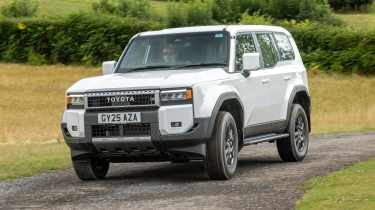
| Pros |
|
| Cons |
|
One area where the Land Cruiser Commercial has a distinct advantage over a double-cab pick-up truck is driving comfort. The Land Cruiser is designed as a passenger carrier first and foremost and doesn’t need to carry a one-tonne payload, so Toyota has fitted it with four-link rear suspension instead of leaf springs. That results in a far more comfortable ride with none of the bouncing that’s associated with trucks such as the Toyota Hilux.
In fact, the driving experience is largely similar to that of the SUV variant, with decent comfort, especially at higher speeds, although a Land Rover Defender with air suspension will still be a better option for a refined ride. There are Eco and Sport modes, although with the former it always feels like you have to put in more effort to achieve the same results; at least Sport mode gives some added response.
The diesel engine is noisy when pushed, though, but the eight-speed gearbox (compared with a six-speed unit for the Hilux) has smooth shifts and helps to keep the engine within its power band, so it only really becomes an issue if you’re accelerating hard.
Town driving, visibility and parking
Around town, the Land Cruiser is slightly shorter than a Hilux, so it’s a bit easier to manoeuvre, although it is still nearly five metres long. Unlike the SUV, the Commercial doesn’t have 360-degree cameras, but front and rear parking sensors and a reversing camera will help in tight spots, as does the light steering, which is surprisingly easy to turn from lock to lock.
One issue that we found with the Land Cruiser Commercial is the restricted visibility that the side window blanks offer. It’s no more pronounced than you’ll find in a panel van, but it does make it harder to check over your shoulder for obstacles.
Motorway driving and long-distance comfort
At higher speeds the Land Cruiser Commercial is just as capable as its SUV sibling. The ride is smooth, the engine settles to a distant hum once you’re up to the national limit and there isn’t much in the way of wind or road noise, either.
Off-road driving
With permanent four-wheel drive and low-range gears, the Land Cruiser Commercial is a capable off-road machine. An electronic diff lock is included to split power 50:50 between the front and rear axles, while there are hill-descent and uphill-start assist systems on offer, too.
Another neat feature is Crawl Control. This is selected via a dashboard button, and is a low-speed cruise control that maintains a set speed for tricky conditions, allowing you to concentrate on steering. It ranges in speed from 1-5mph, and the car’s electronics apply power or braking to maintain the same speed, even over rocks or sand, while you can adjust the car’s speed on the fly by using the rotary drive mode selector on the dashboard when Crawl Control is selected.
Cab interior and technology
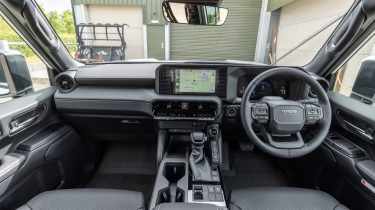
| Pros |
|
| Cons |
|
With its obviously car-derived roots, the Land Cruiser Commercial is a cut above your average work van when it comes to material quality. It’s not quite on a par with a Land Rover Defender, but it’s plusher than the Ineos Grenadier and most pick-up truck rivals. Artificial leather seats boost the cabin’s appeal, while the chunky switchgear adds a rugged look. One obvious difference between the SUV and Commercial model is the addition of a cheap-looking plastic blank that covers the rear electric window switches on the driver’s door – these are no longer wired up and are covered to prevent accidental presses, even though nothing will happen if you do.
There are different grades of plastic throughout the interior, although the gloss-black finish on the centre console is likely to get scratched easily – we’d prefer it if the Commercial model used the same matt silver finish that the Invincible SUV features.
There’s a decent amount of seat adjustment on offer, with the driver’s seat being electrically adjustable. The steel mesh bulkhead is set a little further back than you might find in a panel van, so taller drivers with long legs should be able to set the seat back without it butting into the bulkhead. Reach and rake adjustment comes as standard on the steering wheel, too.
Head and elbow room are good, while cabin storage is a match for that of the SUV variant. You get twin cup-holders next to the drive selector, plus a tray ahead of them to put a smartphone; this space has wireless charging on the SUV, but that’s not offered here. The door bins are deep and the glovebox is handy, while the rear doors still have their standard cards, so there are extra bins for smaller items.
Infotainment, sat-nav and stereo
There’s a nine-inch touchscreen display in the Land Cruiser Commercial, so it’s around three inches smaller than the system found in the SUV. Because it takes up less space in the same binnacle, there’s extra gloss black plastic to either side of the screen. The display itself features all of the usual kit, such as sat-nav, a DAB radio, Bluetooth and smartphone connectivity. There is a column of shortcut buttons to the left of the screen to get you back to the home screen, adjust the audio volume or scroll through the different settings.
The home screen itself is split into four columns that help direct you to convenient functions, but some of the sub-menus can be a little messy and distracting. At least the climate controls are in a separate section below the screen, with a row of toggle buttons and a traditional digital display to operate it.
There’s a digital driver’s display, too, which has fixed water temperature and fuel gauge read-outs on either side, with a small screen between them. This is configurable to show different information via the steering wheel, although the small keys are a little fiddly to use.
Toyota Land Cruiser Commercial alternatives
We’ve already mentioned the Toyota Land Cruiser Commercial’s rivals, with the Ineos Grenadier Commercial and Land Rover Defender Hard Top both starting at a similar price point. Of the two, the Grenadier is the one to choose if off-road driving will be your priority, while the air suspension that’s fitted as standard to the Defender boosts its comfort and refinement on the road. It’s also a much plusher machine from behind the wheel, with more premium materials and upmarket switchgear than either the Toyota or Ineos – we’d argue that the Land Cruiser Commercial falls between the two of them in terms of quality.
One advantage that the Defender has over its competitors is two different body lengths, called 90 and 110. The numbers hark back to the classic Defender, but overall, the two variants are a lot bigger. The Discovery Commercial uses largely the same running gear as the Defender Hard Top, but just comes with a five-door body, while the cabin is a step further upmarket, and it’s more expensive.
All of these models come with torquey six-cylinder engines, so towing should be a breeze. If you’re after a towcar, then a double-cab pick-up truck is worth considering. As well as the Ineos Quartermaster (which is basically the Grenadier but with an open rear bed), the pick of the trucks is the Ford Ranger, with the Volkswagen Amarok and the Toyota Hilux also worth considering. However, beware of business rates for double cabs – because they now pay Benefit-in-Kind tax based on their emissions, they will be costlier to run as a company car. If you can live with the two-seat configuration of a commercial 4x4, it will make better financial sense.
Van dimensions | ||
| Height | Width | Length |
| 1,925mm | 1,980mm | 4,925mm |
Load area dimensions | |||
| Height | Width | Length | Volume |
| 1,090mm | 1,286mm | 1,685mm | 2.0m3 |
Frequently Asked Questions
As with the SUV, the Land Cruiser Commercial offers a decent range of ability. It’s not the ultimate off-roader, but offers more than enough for commercial vehicle users to get to remote locations without much fuss. There’s a mechanical diff lock as standard, while the electronics offer clever settings that take the strain out of off-road driving, although we’d recommend adding all-terrain tyres to make the most of its ability.
Buy your next van with Auto Express. Our nationwide dealer network has some fantastic cars on offer right now with plenty of deals to choose from...

